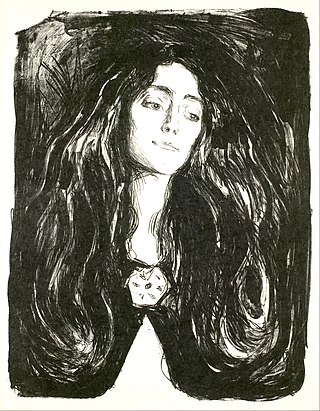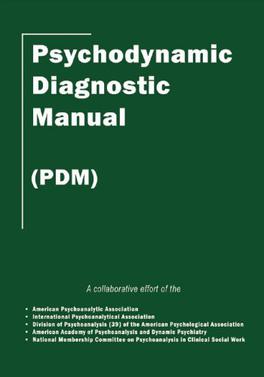
The Diagnostic and Statistical Manual of Mental Disorders is a publication by the American Psychiatric Association (APA) for the classification of mental disorders using a common language and standard criteria. It is an internationally accepted manual on the diagnosis and treatment of mental disorders, though it may be used in conjunction with other documents. Other commonly used principal guides of psychiatry include the International Classification of Diseases (ICD), Chinese Classification of Mental Disorders (CCMD), and the Psychodynamic Diagnostic Manual. However, not all providers rely on the DSM-5 as a guide, since the ICD's mental disorder diagnoses are used around the world, and scientific studies often measure changes in symptom scale scores rather than changes in DSM-5 criteria to determine the real-world effects of mental health interventions.

Dissociative fugue, formerly called a fugue state or psychogenic fugue, is a rare psychiatric phenomenon characterized by reversible amnesia for one's identity in conjunction with unexpected wandering or travel. This is sometimes accompanied by the establishment of a new identity and the inability to recall personal information prior to the presentation of symptoms. Dissociative fugue is a mental and behavioral disorder that is classified variously as a dissociative disorder, a conversion disorder, and a somatic symptom disorder. It is a facet of dissociative amnesia, according to the fifth edition of the Diagnostic and Statistical Manual of Mental Disorders (DSM-5).
Dissociative identity disorder (DID), previously known as multiple personality disorder (MPD), is one of multiple dissociative disorders in the DSM-5, DSM-5-TR, ICD-10, ICD-11, and Merck Manual. It has a history of extreme controversy.

Borderline personality disorder (BPD), also known as emotionally unstable personality disorder (EUPD), is a personality disorder characterized by a pervasive, long-term pattern of significant interpersonal relationship instability, a distorted sense of self, and intense emotional responses. People diagnosed with BPD frequently exhibit self-harming behaviours and engage in risky activities, primarily due to challenges regulating emotional states to a healthy, stable baseline. Symptoms such as dissociation, a pervasive sense of emptiness, and an acute fear of abandonment are prevalent among those affected.
Dissociation is a concept that has been developed over time and which concerns a wide array of experiences, ranging from a mild emotional detachment from the immediate surroundings, to a more severe disconnection from physical and emotional experiences. The major characteristic of all dissociative phenomena involves a detachment from reality, rather than a false perception of reality as in psychosis.
Pervasive developmental disorder not otherwise specified (PDD-NOS) is a historic psychiatric diagnosis first defined in 1980 that has since been incorporated into autism spectrum disorder in the DSM-5 (2013).
Conversion disorder (CD), or functional neurologic symptom disorder (FNsD), is a functional disorder that causes abnormal sensory experiences and movement problems during periods of high psychological stress. Individuals with CD present with highly distressing neurological symptoms such as numbness, blindness, paralysis, or convulsions, which are not consistent with a well-established organic cause and can be traced back to a psychological trigger.
Ganser syndrome is a rare dissociative disorder characterized by nonsensical or wrong answers to questions and other dissociative symptoms such as fugue, amnesia or conversion disorder, often with visual pseudohallucinations and a decreased state of consciousness. The syndrome has also been called nonsense syndrome, balderdash syndrome, syndrome of approximate answers, hysterical pseudodementia or prison psychosis.
Dissociative disorders (DDs) are a range of conditions characterized by significant disruptions or fragmentation "in the normal integration of consciousness, memory, identity, emotion, perception, body representation, motor control, and behavior." Dissociative disorders involve involuntary dissociation as an unconscious defense mechanism, wherein the individual with a dissociative disorder experiences separation in these areas as a means to protect against traumatic stress. Some dissociative disorders are caused by major psychological trauma, though the onset of depersonalization-derealization disorder may be preceded by less severe stress, by the influence of psychoactive substances, or occur without any discernible trigger.
Psychogenic non-epileptic seizures (PNES), also referred to as pseudoseizures, non-epileptic attack disorder (NEAD), functional seizures, or dissociative seizures, are episodes resembling an epileptic seizure but without the characteristic electrical discharges associated with epilepsy. PNES fall under the category of disorders known as functional neurological disorders (FND) and are typically treated by psychologists or psychiatrists.

Complex post-traumatic stress disorder is a stress-related mental disorder generally occurring in response to complex traumas, i.e., commonly prolonged or repetitive exposures to a series of traumatic events, within which individuals perceive little or no chance to escape.

The Psychodynamic Diagnostic Manual (PDM) is a diagnostic handbook similar to the International Statistical Classification of Diseases and Related Health Problems (ICD) or the Diagnostic and Statistical Manual of Mental Disorders (DSM). The PDM was published on May 28, 2006.

The Diagnostic and Statistical Manual of Mental Disorders, Fifth Edition (DSM-5), is the 2013 update to the Diagnostic and Statistical Manual of Mental Disorders, the taxonomic and diagnostic tool published by the American Psychiatric Association (APA). In 2022, a revised version (DSM-5-TR) was published. In the United States, the DSM serves as the principal authority for psychiatric diagnoses. Treatment recommendations, as well as payment by health care providers, are often determined by DSM classifications, so the appearance of a new version has practical importance. However, some providers instead rely on the International Statistical Classification of Diseases and Related Health Problems (ICD), and scientific studies often measure changes in symptom scale scores rather than changes in DSM-5 criteria to determine the real-world effects of mental health interventions. The DSM-5 is the only DSM to use an Arabic numeral instead of a Roman numeral in its title, as well as the only living document version of a DSM.
Personality disorders (PD) are a class of mental disorders characterized by enduring maladaptive patterns of behavior, cognition, and inner experience, exhibited across many contexts and deviating from those accepted by the individual's culture. These patterns develop early, are inflexible, and are associated with significant distress or disability. The definitions vary by source and remain a matter of controversy. Official criteria for diagnosing personality disorders are listed in the sixth chapter of the International Classification of Diseases (ICD) and in the American Psychiatric Association's Diagnostic and Statistical Manual of Mental Disorders (DSM).
Personality disorder not otherwise specified (PD-NOS) is a subclinical diagnostic classification for some DSM-IV Axis II personality disorders not listed in DSM-IV.
Compulsive sexual behaviour disorder (CSBD), is an impulse control disorder. CSBD manifests as a pattern of behavior involving intense preoccupation with sexual fantasies and behaviours that cause significant levels of psychological distress, are inappropriately used to cope with psychological stress, cannot be voluntarily curtailed, and risk or cause harm to oneself or others. This disorder can also cause impairment in social, occupational, personal, or other important functions. CSBD is not an addiction, and is typically used to describe behavior, rather than "sexual addiction".
According to some classification systems, Sexual masochism disorder is the condition of experiencing recurring and intense sexual arousal in response to enduring moderate or extreme pain, suffering, or humiliation. The Diagnostic and Statistical Manual (DSM-5) of the American Psychiatric Association indicates that a person may have a masochistic sexual interest but that the diagnosis of sexual masochism disorder would only apply to individuals who also report psychosocial difficulties because of it.
Homosexuality was classified as a mental disorder in the Diagnostic and Statistical Manual of Mental Disorders (DSM) beginning with the first edition, published in 1952 by the American Psychiatric Association (APA). This classification was challenged by gay rights activists during the gay liberation following the 1969 Stonewall riots, and in December 1973, the APA board of trustees voted to declassify homosexuality as a mental disorder. In 1974, the DSM was updated and homosexuality was replaced with a new diagnostic code for individuals distressed by their homosexuality, termed ego-dystonic sexual orientation. Distress over one's sexual orientation remained in the manual, under different names, until the DSM-5 in 2013.
Other specified dissociative disorder (OSDD) is a mental health diagnosis for pathological dissociation that matches the DSM-5 criteria for a dissociative disorder, but does not fit the full criteria for any of the specifically identified subtypes, which include dissociative identity disorder, dissociative amnesia, and depersonalization/derealization disorder, and the reasons why the previous diagnoses were not met are specified. "Unspecified dissociative disorder" is given when the clinician does not give a reason. The International Statistical Classification of Diseases and Related Health Problems (ICD-10) refers to the diagnosis as "Other dissociative and conversion disorders". Under the fourth edition of the Diagnostic and Statistical Manual of Mental Disorders (DSM), it was known as "Dissociative disorder not otherwise specified" (DDNOS).






